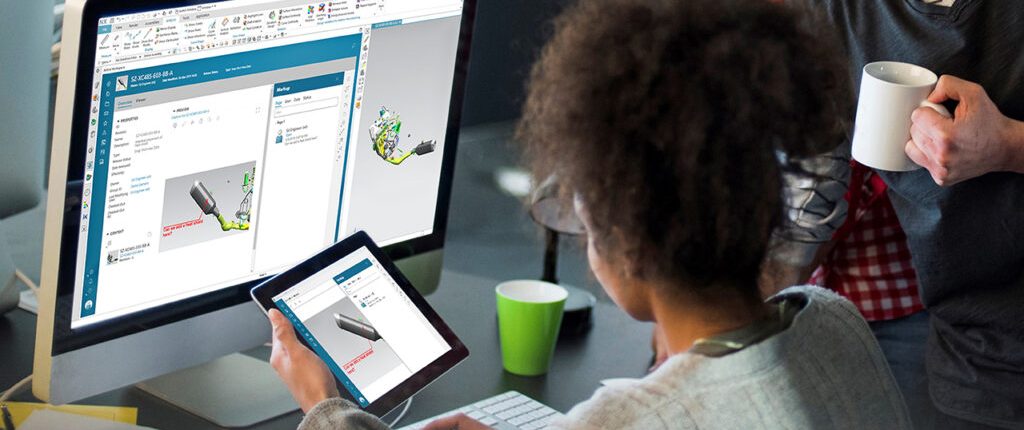
Accelerate industry 4.0 using collaboration software | Teamcenter
Our team at FEALINX has worked with Siemens to solve challenges in manufacturing for more than 22 years. Over the past decade, we’ve seen Industry 4.0 planning and implementations grow from “nice-to-have” to accelerated adoption of digital processes across the entire manufacturing lifecycle. Why? Because Industry 4.0 transformations deliver benefits such as agility, productivity, and cross-functional collaboration and enable the creation of vastly improved products that go to market faster.
Yes, COVID changed all that — and more.
Between 2011 (when Industry 4.0 began) and 2019 before the pandemic, advancements towards digitization of the manufacturing sector plodded along steadily. Initiatives were often folded into the mix as time and resources allowed. Flash forward to late 2019 when the pandemic upended everything, and the world shuttered in place. People went home to work, and manufacturers that embraced digitalization were well-positioned to weather the impact and come out ahead. Those in the process of Industry 4.0 transformations quickly expedited their journey while companies without any real digital traction experienced a five-alarm call to action! With other large-scale global impacts looming, the ‘new normal is to be nimble, requiring Industry 4.0 transformations that often start with product lifecycle management (PLM) software.
The future of PLM and Industry 4.0
Perspectives on PLM’s role in the future of digitized manufacturing are twofold. Many speculate that PLM will work alongside Industry 4.0 to drive organizational value between program creation and sourcing, from R&D to the assembly line, and along the path from factory to consumers. Others expect that leveraging PLM technology to extend continuity of lifecycle management across the broader organization will lead to new business models and data-driven products going to market faster. Both make a good case for a PLM solution when the chosen product serves underlying goals and is scalable for the future – which includes interfacing with other technologies in the manufacturing IT stack such as ERP, CAD, CAM, and simulation software.
Long live the cloud!
Cloud-based services make PLM and other Industry 4.0 solutions more financially accessible and easier to manage for manufacturers. The result is an industry-wide amplification of the benefits of Industry 4.0, including a significant positive impact on product innovation and quality. Therefore, as cloud-based PLM technology usage grows, more companies gain access to self-guided and efficient user experiences, auto-executed product upgrades, and shared access to their data to inform design, engineering, and manufacturing decisions. This is a game-changer for those ready to grow.
Teamcenter accelerates Industry 4.0
At FEALINX, we see firsthand how fiercely competitive the globalized manufacturing environment is as companies vie to become leaders in expediting the development and distribution of excellent quality products. The right PLM solution makes this possible. Teamcenter as a PLM foundation facilitates cross-functional collaboration, delivers a shared source of the bill of materials information, and reduces manual PLM management and tracking for our customers. Teamcenter also improves document publishing, reduces time and cost of development, ensures compliance, and addresses sustainability needs, materials data, and lifecycle management — plus a lot more. In essence, Teamcenter is a flexible, robust solution that solves a wide array of customer challenges.
Better decisions, better products: How customers use Teamcenter
Soletanche Bachy: The engineering and material manufacturing department at this general foundation and soil technology company was eager to optimize internal operations and gain productivity. The firm understood that several legacies and siloed product data management (PDM) solutions and computer-aided design (CAD) and AutoCAD solutions needed to be replaced. After consulting with FEALINX, our team showed Soletanche Bachy how easily Teamcenter interfaces with digital communication tools surrounding engineering and manufacturing bills of materials. Soletanche Bachy was impressed with Teamcenter’s user-friendliness — both of which topped their list of requirements.
KTK Seats: Upholstered seats for automobiles and trains were saddled with outdated software. When we first spoke with KTK Seats, it was clear that their initial needs included framing business processes in PLM, structuring a database of knowledge and products, and connecting the solution with its existing SAP ERP instance. Our FEALINX team deployed Teamcenter, which integrated with the SAP ERP solution and further increased productivity through modernization of KTK Seat’s design office — including structuring technical data from engineering that avoided multiplication of files while providing a fluid process for indicating and versioning parts.
Groupe Brandt: A leading international appliance manufacturer with footprints across Europe, Asia, and North Africa, was challenged by unconnected and dissimilar systems across its 11 locations. Our team at FEALINX agreed, Groupe Brant needed standardized tools and processes that address the needs of all areas while delivering shared access to increase collaboration. Working together on a strategy, we deployed Teamcenter for shared access to manage part references, cycle statuses, reviews, product upgrades, and a product lifecycle data repository to ease lifecycle management. Read the full use case.
As a solution provider in the manufacturing sector for over two decades, FEALINX encourages companies to leverage technology to drive efficiency, productivity, and sustainability and is committed to providing best-in-class customer solutions. Sebastien DEBEIX is the director of strategic partnerships and communications at FEALINX. As a passionate advocate for the digital transformation of companies, he has helped his teams of experts.

Don’t hesitate to contact Thanh for advice on automation solutions for CAD / CAM / CAE / PLM / ERP / IT systems exclusively for SMEs.
Luu Phan Thanh (Tyler) Solutions Consultant at PLM Ecosystem Mobile +84 976 099 099
Web www.plmes.io Email tyler.luu@plmes.io
